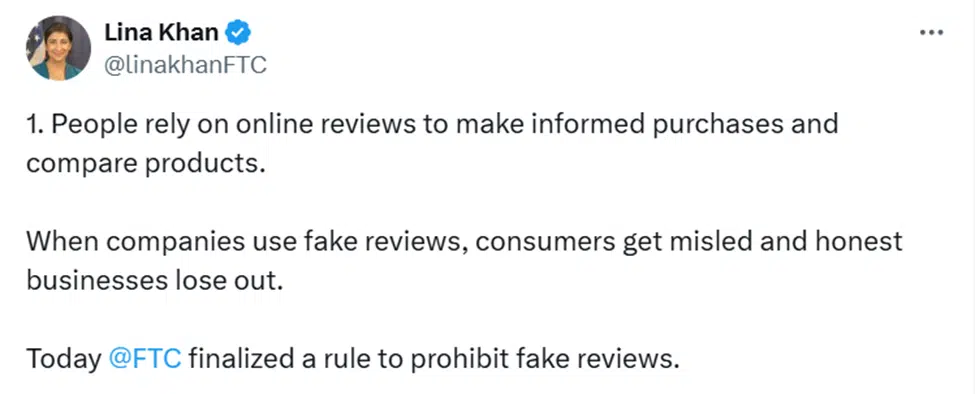The Federal Trade Commission’s (FTC) final rule banning fake reviews officially took effect on Oct. 21, marking a significant milestone in the fight against deceptive online practices.
This comprehensive regulation, with penalties of $50,120 per violation, fundamentally changes how businesses must approach their online review practices and local SEO strategies.
Why this matters now
FTC Chair Lina Khan emphasized the importance of this implementation, stating:
- “Fake reviews don’t only waste people’s time and money, they also pollute the marketplace and divert business away from honest competitors.”
This final rule represents the culmination of the FTC’s efforts to create a more transparent and fair marketplace where authentic customer experiences – not manufactured testimonials – drive business success.
What’s banned under the new policy
The FTC’s rule establishes clear boundaries for review practices, prohibiting:
- Fake reviews: Including AI-generated reviews and testimonials from users who haven’t experienced the product or service.
- Purchased reviews: Both positive and negative reviews that were bought or incentivized.
- Insider reviews: Reviews from employees, their families or company affiliates.
- Review suppression: Using threats or intimidation to remove negative reviews.
- Company-controlled review sites: Presenting company-owned review platforms as independent.
- False social proof: Buying followers or views to create artificial social media influence.
Fake reviews mislead customers who are looking to buy from genuine businesses. When companies use these fake reviews to pull customers in, they deceive them based on inaccurate information.
Lina Khan says as much in her post on X.

Real-world enforcement examples
Fashion Nova faced a $4.2 million fine for blocking negative reviews from its website, only allowing 4- and 5-star ratings to appear.
Similarly, Roomster, a rental listing platform, was penalized for using thousands of fake positive reviews to deceive potential renters about their service quality.
These cases demonstrate the FTC’s serious approach to enforcement and the substantial penalties businesses face for violations.
Dig deeper: Google says it took down 45% more fake reviews in 2023 thanks to new algorithm
Understanding the legal framework
The FTC’s enforcement strategy includes multiple checks and balances to ensure compliance, including civil penalties, cease and desist orders and direct lawsuits against violators.
Businesses have a 60-day grace period after Federal Register publication to align their practices with the new requirements.
To ensure compliance, businesses should consider a similar timeline.
Days 1-15: Audit current review practices
- Review all platforms where your business appears and document current collection methods to identify non-compliant practices.
Days 16-30: Develop new procedures
- Create compliant review request templates and establish documentation systems while developing staff training materials.
Days 31-45: Staff training and implementation
- Train customer-facing staff, update automated systems and test new procedures.
Days 46-60: Monitor and adjust
- Audit new practices, gather feedback and make necessary adjustments.
Direct impact on local business operations
Google Business Profile management
Your Google Business Profile (GBP) often provides potential customers’ first impression of your business.
Under the new FTC rules, maintaining a compliant and effective presence requires careful attention to several key areas.
First, businesses must overhaul their review collection strategy. Consider these examples of compliant versus non-compliant approaches:
Compliant review request
- “Thank you for choosing our service. We value honest feedback from our customers. If you’d like to share your experience, you can leave a review on our Google Business Profile. Your genuine feedback helps other customers make informed decisions.”
Non-compliant request (now banned)
- “Leave us a 5-star review and get 10% off your next purchase!”
Response management also requires a systematic approach. Here are effective templates that build trust while maintaining compliance.
Positive review response
- “Thank you [Name] for taking the time to share your experience! We’re glad to hear that [specific detail from their review] met your expectations. We look forward to serving you again!”
Negative review response
- “[Name], we appreciate your honest feedback about [specific issue]. We take this seriously and would like to address your concerns. Please contact our customer service team at [contact method] so we can make this right. Your satisfaction is important to us.”
Dig deeper: How to handle negative Google reviews: Remove, respond, recover
Get the newsletter search marketers rely on.
SEO implications of the FTC policy
The FTC’s new policy fundamentally strengthens Google’s existing preference for authentic reviews, creating far-reaching implications for local search rankings.
Businesses that have relied heavily on review quantity over quality could see significant changes in their search visibility.
Google’s algorithms are becoming increasingly sophisticated in detecting review authenticity, considering factors like content originality, posting patterns and reviewer credibility.
This aligns perfectly with the FTC’s new requirements, effectively creating a double incentive for businesses to maintain genuine review practices.
The local map pack will become even more competitive. Businesses can no longer rely on volume alone. Instead, factors like genuine positive reviews, consistent response rates and authentic engagement will play crucial roles in determining rankings.
Businesses must view reviews as an extension of their customer service strategy rather than a marketing tool.
Implementation guide: Building a sustainable review strategy
The transition to FTC-compliant reviews requires more than just following rules, it’s about rethinking how you connect with customers and handle your online reputation.
From policy to practice
Staff training becomes crucial. Your team needs to understand not just what’s prohibited but why authentic reviews matter. This understanding helps them naturally encourage real feedback without crossing compliance lines.
Training sessions should focus on real-world scenarios, helping staff recognize the difference between encouraging honest feedback and soliciting positive reviews.
Customer interaction points need careful consideration. The best review requests often come at natural moments in the customer journey.
Perhaps after a successful service completion or during a follow-up interaction. These moments allow for natural conversations about feedback.
Monitoring and management
While maintaining compliance is crucial, businesses must stay alert to potential issues that could trigger FTC scrutiny. Red flags often appear in patterns rather than isolated incidents.
Watch for sudden changes in review velocity or suspicious patterns in review language. These might indicate unauthorized review generation practices within your organization or attacks from competitors.
Dig deeper: How to respond to negative reviews harming your company’s reputation
Future outlook: Beyond compliance
The FTC’s new rule marks the beginning of how businesses approach online reputation management.
New developments will likely shape the future of review management and local SEO.
New technology
The push for review authenticity is driving innovation in verification technology.
Blockchain solutions are emerging to create immutable records of verified purchases and legitimate reviews.
AI systems are becoming more sophisticated at detecting patterns that indicate review manipulation, while platforms are developing new methods to verify reviewer identity without compromising user privacy.
Review platform updates
Review sites like Yelp, Google Business Profile and Trustpilot are expected to tighten up their verification processes in 2025.
We’ll likely see them introduce stronger user verification methods, better connections between purchases and reviews and clearer ways of showing how reviews are collected and displayed.
Make trust a foundation of your local SEO efforts
The FTC’s review policy represents more than just regulatory compliance. It’s an opportunity to rebuild customer trust in online reviews.
The future of local SEO will increasingly reward businesses that prioritize authentic customer experiences over artificial metrics.
By focusing on genuine engagement, maintaining documentation and staying ahead of technological changes, you can turn these regulatory requirements into competitive advantages.
Success won’t come from finding new ways to game the system but from excelling at the fundamentals – providing excellent service, engaging honestly with customers and earning legitimate positive reviews through consistent quality and care.
Contributing authors are invited to create content for Search Engine Land and are chosen for their expertise and contribution to the search community. Our contributors work under the oversight of the editorial staff and contributions are checked for quality and relevance to our readers. The opinions they express are their own.





